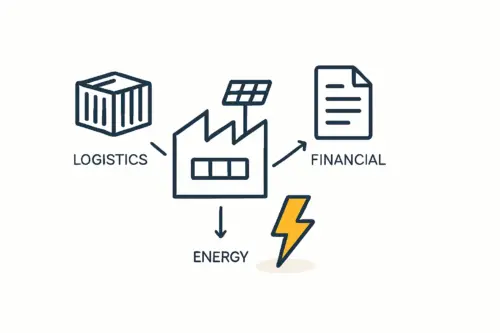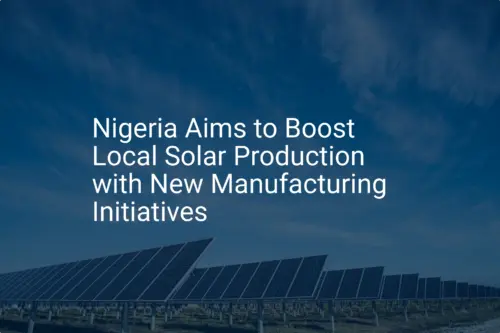A new solar module factory in Nigeria was just starting operations. The production line was running, and the team was laminating its first commercial batch of solar panels—a critical, heat-intensive process. Midway through the cycle, the facility fell silent. The national grid had failed, and the backup generator took too long to engage. The entire batch, representing thousands of dollars in materials, was lost.
This scenario, shared by Nigerian factory owner Julius Etim, is not an isolated one. As he put it, ‘Our biggest operational headache was not sourcing materials, but keeping the lights on. The national grid was a gamble we couldn’t afford to take.’ For any entrepreneur planning to set up a solar panel manufacturing plant in Nigeria, mastering the facility’s power strategy is foundational to success.
The Scope of Nigeria’s Power Challenge for Manufacturers
Nigeria’s energy situation presents a significant paradox. While the country has an installed electricity generation capacity of over 13,000 megawatts (MW), its operational output often hovers between 3,500 and 5,000 MW. This disparity leads to an unstable grid that suffered over 200 system collapses between 2010 and 2019.
For the manufacturing sector, the consequences are severe:
-
High Operational Costs: Unreliable grid power forces businesses to rely on diesel generators. This dependence is so widespread that it costs Nigerian businesses an estimated $14 billion annually. For many manufacturers, power can account for up to 40% of total operational expenditure, directly impacting profitability and competitiveness.
-
Production Interruptions: Solar module manufacturing involves sensitive, continuous processes. An unexpected power outage during lamination or cell testing can lead to material waste, defective products, and costly downtime.
-
Equipment Damage: Voltage surges and dips from an unstable grid can damage sophisticated manufacturing machines, such as laminators, stringers, and solar simulators, leading to expensive repairs and production delays.
Addressing this energy challenge isn’t just an operational task—it is a strategic imperative that must be part of the initial business plan.
Core Strategies for Energy Independence
To counter the unreliability of the grid, a factory must develop its own robust power infrastructure. The goal is to create a resilient system that ensures a constant, stable supply of high-quality power. This usually requires a multi-layered approach.
Strategy 1: The Diesel Generator as a Baseline
For decades, the diesel generator has been the default backup power solution in Nigeria—a known technology that provides a reliable source of power when the grid fails.
Ready to make big Profits?
The solar Industry is Booming
WE HELP NEWCOMERS to the solar industry start their own solar module production line. Customers can make BIG PROFITS by selling modules and finding investors, without wasting money and time on things they don't need!
Its limitations, however, are significant. The fluctuating cost of diesel fuel introduces financial unpredictability. Furthermore, generators require regular, specialized maintenance and produce significant noise and emissions, creating challenges for environmental compliance and workplace conditions. While necessary as a final backstop, relying solely on diesel is an expensive and inefficient long-term strategy.
Strategy 2: Captive Solar Power Plants
A logical step for a solar module manufacturer is to use its own product. Nigeria benefits from high solar irradiation, averaging 4.0 to 6.5 kWh/m² per day. A captive solar photovoltaic (PV) plant, installed on the factory roof or adjacent land, can generate a substantial portion of the facility’s daytime energy needs.
This approach offers several advantages:
-
Lower Energy Costs: It reduces dependence on expensive grid electricity and diesel.
-
Predictable Budgets: Solar energy provides a stable, low operating cost, insulating the business from fuel price volatility.
-
Brand Alignment: It demonstrates the viability and effectiveness of the product being manufactured.
Strategy 3: Integrating Battery Energy Storage Systems (BESS)
While a solar plant addresses daytime energy needs, manufacturing often continues beyond daylight hours. A Battery Energy Storage System (BESS) is the key to unlocking 24/7 energy independence.
A BESS stores excess energy generated by the solar plant during the day and deploys it when needed: at night, during peak demand, or instantly during a grid outage. It acts as an uninterruptible power supply (UPS) on an industrial scale, shielding sensitive equipment from any power disruption.
The Hybrid Power System: A Comprehensive Solution
The most effective and resilient strategy combines all three elements—grid, solar, and diesel—into a single, intelligent hybrid system managed by sophisticated power controllers.
This integrated system operates on a priority basis:
-
Primary Source: The factory runs on solar power during the day, with the battery storing any excess generation.
-
Secondary Source: At night or on cloudy days, the system draws from the charged batteries.
-
Tertiary Source: If the batteries are depleted, the system can draw from the grid, especially during off-peak hours when tariffs may be lower.
-
Backup Source: The diesel generator engages only as a last resort, such as during a prolonged grid outage combined with poor solar generation.
Based on experience from J.v.G. Technology turnkey projects, this hybrid model provides the optimal balance of reliability, cost-efficiency, and operational autonomy.
The Business Case: From Operational Cost to Competitive Advantage
Investing in a hybrid power system isn’t just an expense; it’s a strategic investment in operational stability and long-term profitability. The levelized cost of energy (LCOE)—the average cost per unit of electricity generated over an asset’s lifetime—tells a clear story.
As the graph illustrates, while the initial capital expenditure for a solar and battery system is higher, its LCOE is significantly lower than that of a diesel generator. Over time, this translates into substantial savings, reduced operational risk, and a stronger competitive position in the market.
Frequently Asked Questions (FAQ)
What is the typical payback period for a solar and storage system for a factory?
The payback period depends on factors like system size, local solar irradiation, and the prevailing costs of grid electricity and diesel. For industrial applications in Nigeria, payback periods of 5 to 8 years are common, after which the system generates nearly free electricity for the remainder of its 20- to 25-year lifespan.
How much space is needed for a captive solar plant?
A general rule of thumb is that 1 MW of solar PV capacity requires approximately 1 hectare (10,000 square meters) of ground space or a similar amount of unobstructed roof area. A detailed assessment should be part of the initial factory design.
Can a hybrid system power all factory machines?
Yes. A properly sized hybrid power system, including a robust BESS, is designed to handle the high inrush currents of heavy machinery and provide clean, stable power for all equipment, from administrative offices to the entire production line.
What are the maintenance requirements for a solar and BESS installation?
Solar PV systems require minimal maintenance, primarily periodic cleaning of the panels. Battery systems require professional monitoring and adherence to manufacturer guidelines, but modern lithium-ion systems are designed for long-life, low-maintenance operation. This is significantly less burdensome than the constant upkeep required for diesel generators.
Conclusion: Planning for Power Resilience from Day One
For any entrepreneur entering the solar manufacturing sector in Nigeria, the national grid’s instability is a critical business risk. However, it’s a risk that can be effectively managed through strategic planning and investment in an independent, hybrid power system.
By integrating captive solar, battery storage, and a generator backup, a factory can achieve a high degree of energy autonomy. This approach transforms a major operational liability into a competitive advantage, ensuring production continuity, protecting valuable equipment, and building a foundation for long-term financial success.
To guide you through this essential planning phase, the pvknowhow.com platform provides structured educational resources and courses for entrepreneurs.









